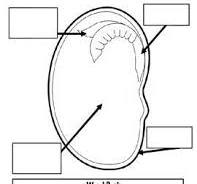The number of soil layers.
What is 6?
A rock formed by intense heat and pressure underground.
What is metamorphic rock?
Green pigment found in a plant's leaves; helps the plant to make food.
What is chlorophyll?
The part of the leaf that helps the leaf catch sunlight and rain.
What is the tip (apex) of the leaf?
A young plant developing inside a see that has not germinated?
What is an embryo?
The very dark, top, rich, and fertile part of the soil.
What is humus?
Made up of tiny rock particles that cling together and do not allow water to flow through easily.
What is clay?
The process that plants use to make food.
What is photosynthesis?
Name of #4
What is the blade?
Develops into the stem of the plant.
What is the hypocotyl?
Each layer of soil is called.
What is horizon?
Rock formed from magma or lava when it cools and hardens.
What is igneous rock?
The type of food that plants make in their leaves.
What is glucose (sugar)?
Name #6
What is the petiole?
Develops into the root of the plant.
What is the radicle?
The hard, solid, unweathered rock layer beneath the loose soil and sediment, forming the base of the Earth's crust.
What is bedrock?
The Kissing Camels are made of this kind of rock?
What is sandstone or limestone?
Water, sunlight, carbon dioxide, chlorophyll, and nutients.
What do plants need to grow?
The main road that run's down the center of the leaf, and helps the leaf stay flat, and gives it structure.
What is the midrib?
Protective outer coating of the seed.
What is the seed coat?
This layer of soil is made of rock fragments.
What is parent rock?
The process by which soil and rock are removed from one area of the Earth through natural causes, such as wind, water, and ice, and transported elsewhere.
What is erosion?
Parts of a plant.
What are the roots, stems, leaves, flowers, fruits, and seeds.
The mouth-like structures on the bottom of a leaf that are crucial for gas exchange (allowing carbon dioxide to enter and oxygen to exit) and transpiration (the release of water vapor)
What is the stomata?
Name all 4 parts.

What is the epicotyl, hypocotyl, cotyledon, and the seed coat.